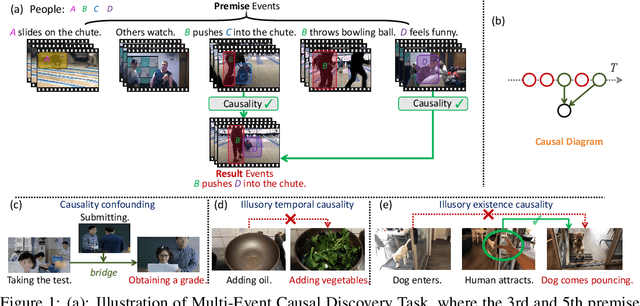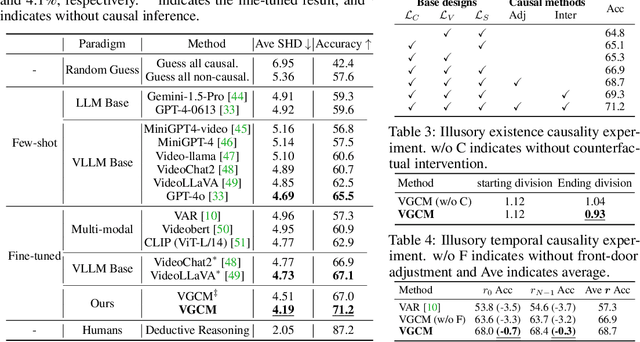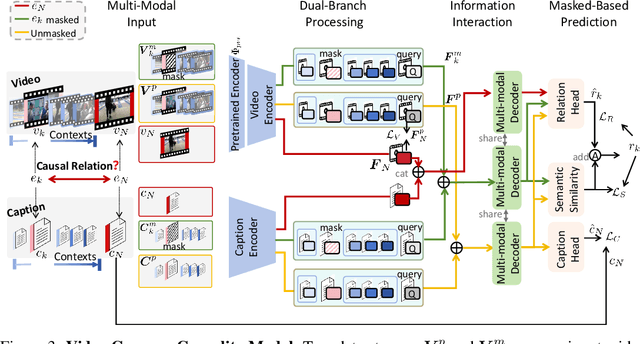Huabin Liu
CogStream: Context-guided Streaming Video Question Answering
Jun 12, 2025Abstract:Despite advancements in Video Large Language Models (Vid-LLMs) improving multimodal understanding, challenges persist in streaming video reasoning due to its reliance on contextual information. Existing paradigms feed all available historical contextual information into Vid-LLMs, resulting in a significant computational burden for visual data processing. Furthermore, the inclusion of irrelevant context distracts models from key details. This paper introduces a challenging task called Context-guided Streaming Video Reasoning (CogStream), which simulates real-world streaming video scenarios, requiring models to identify the most relevant historical contextual information to deduce answers for questions about the current stream. To support CogStream, we present a densely annotated dataset featuring extensive and hierarchical question-answer pairs, generated by a semi-automatic pipeline. Additionally, we present CogReasoner as a baseline model. It efficiently tackles this task by leveraging visual stream compression and historical dialogue retrieval. Extensive experiments prove the effectiveness of this method. Code will be released soon.
Looking Beyond Visible Cues: Implicit Video Question Answering via Dual-Clue Reasoning
Jun 09, 2025Abstract:Video Question Answering (VideoQA) aims to answer natural language questions based on the given video, with prior work primarily focusing on identifying the duration of relevant segments, referred to as explicit visual evidence. However, explicit visual evidence is not always directly available, particularly when questions target symbolic meanings or deeper intentions, leading to significant performance degradation. To fill this gap, we introduce a novel task and dataset, $\textbf{I}$mplicit $\textbf{V}$ideo $\textbf{Q}$uestion $\textbf{A}$nswering (I-VQA), which focuses on answering questions in scenarios where explicit visual evidence is inaccessible. Given an implicit question and its corresponding video, I-VQA requires answering based on the contextual visual cues present within the video. To tackle I-VQA, we propose a novel reasoning framework, IRM (Implicit Reasoning Model), incorporating dual-stream modeling of contextual actions and intent clues as implicit reasoning chains. IRM comprises the Action-Intent Module (AIM) and the Visual Enhancement Module (VEM). AIM deduces and preserves question-related dual clues by generating clue candidates and performing relation deduction. VEM enhances contextual visual representation by leveraging key contextual clues. Extensive experiments validate the effectiveness of our IRM in I-VQA tasks, outperforming GPT-4o, OpenAI-o3, and fine-tuned VideoChat2 by $0.76\%$, $1.37\%$, and $4.87\%$, respectively. Additionally, IRM performs SOTA on similar implicit advertisement understanding and future prediction in traffic-VQA. Datasets and codes are available for double-blind review in anonymous repo: https://github.com/tychen-SJTU/Implicit-VideoQA.
MECD+: Unlocking Event-Level Causal Graph Discovery for Video Reasoning
Jan 16, 2025Abstract:Video causal reasoning aims to achieve a high-level understanding of videos from a causal perspective. However, it exhibits limitations in its scope, primarily executed in a question-answering paradigm and focusing on brief video segments containing isolated events and basic causal relations, lacking comprehensive and structured causality analysis for videos with multiple interconnected events. To fill this gap, we introduce a new task and dataset, Multi-Event Causal Discovery (MECD). It aims to uncover the causal relations between events distributed chronologically across long videos. Given visual segments and textual descriptions of events, MECD identifies the causal associations between these events to derive a comprehensive and structured event-level video causal graph explaining why and how the result event occurred. To address the challenges of MECD, we devise a novel framework inspired by the Granger Causality method, incorporating an efficient mask-based event prediction model to perform an Event Granger Test. It estimates causality by comparing the predicted result event when premise events are masked versus unmasked. Furthermore, we integrate causal inference techniques such as front-door adjustment and counterfactual inference to mitigate challenges in MECD like causality confounding and illusory causality. Additionally, context chain reasoning is introduced to conduct more robust and generalized reasoning. Experiments validate the effectiveness of our framework in reasoning complete causal relations, outperforming GPT-4o and VideoChat2 by 5.77% and 2.70%, respectively. Further experiments demonstrate that causal relation graphs can also contribute to downstream video understanding tasks such as video question answering and video event prediction.
CSTA: Spatial-Temporal Causal Adaptive Learning for Exemplar-Free Video Class-Incremental Learning
Jan 13, 2025



Abstract:Continual learning aims to acquire new knowledge while retaining past information. Class-incremental learning (CIL) presents a challenging scenario where classes are introduced sequentially. For video data, the task becomes more complex than image data because it requires learning and preserving both spatial appearance and temporal action involvement. To address this challenge, we propose a novel exemplar-free framework that equips separate spatiotemporal adapters to learn new class patterns, accommodating the incremental information representation requirements unique to each class. While separate adapters are proven to mitigate forgetting and fit unique requirements, naively applying them hinders the intrinsic connection between spatial and temporal information increments, affecting the efficiency of representing newly learned class information. Motivated by this, we introduce two key innovations from a causal perspective. First, a causal distillation module is devised to maintain the relation between spatial-temporal knowledge for a more efficient representation. Second, a causal compensation mechanism is proposed to reduce the conflicts during increment and memorization between different types of information. Extensive experiments conducted on benchmark datasets demonstrate that our framework can achieve new state-of-the-art results, surpassing current example-based methods by 4.2% in accuracy on average.
Commonsense Video Question Answering through Video-Grounded Entailment Tree Reasoning
Jan 09, 2025



Abstract:This paper proposes the first video-grounded entailment tree reasoning method for commonsense video question answering (VQA). Despite the remarkable progress of large visual-language models (VLMs), there are growing concerns that they learn spurious correlations between videos and likely answers, reinforced by their black-box nature and remaining benchmarking biases. Our method explicitly grounds VQA tasks to video fragments in four steps: entailment tree construction, video-language entailment verification, tree reasoning, and dynamic tree expansion. A vital benefit of the method is its generalizability to current video and image-based VLMs across reasoning types. To support fair evaluation, we devise a de-biasing procedure based on large-language models that rewrites VQA benchmark answer sets to enforce model reasoning. Systematic experiments on existing and de-biased benchmarks highlight the impact of our method components across benchmarks, VLMs, and reasoning types.
MECD: Unlocking Multi-Event Causal Discovery in Video Reasoning
Sep 26, 2024



Abstract:Video causal reasoning aims to achieve a high-level understanding of video content from a causal perspective. However, current video reasoning tasks are limited in scope, primarily executed in a question-answering paradigm and focusing on short videos containing only a single event and simple causal relationships, lacking comprehensive and structured causality analysis for videos with multiple events. To fill this gap, we introduce a new task and dataset, Multi-Event Causal Discovery (MECD). It aims to uncover the causal relationships between events distributed chronologically across long videos. Given visual segments and textual descriptions of events, MECD requires identifying the causal associations between these events to derive a comprehensive, structured event-level video causal diagram explaining why and how the final result event occurred. To address MECD, we devise a novel framework inspired by the Granger Causality method, using an efficient mask-based event prediction model to perform an Event Granger Test, which estimates causality by comparing the predicted result event when premise events are masked versus unmasked. Furthermore, we integrate causal inference techniques such as front-door adjustment and counterfactual inference to address challenges in MECD like causality confounding and illusory causality. Experiments validate the effectiveness of our framework in providing causal relationships in multi-event videos, outperforming GPT-4o and VideoLLaVA by 5.7% and 4.1%, respectively.
DIBS: Enhancing Dense Video Captioning with Unlabeled Videos via Pseudo Boundary Enrichment and Online Refinement
Apr 03, 2024



Abstract:We present Dive Into the BoundarieS (DIBS), a novel pretraining framework for dense video captioning (DVC), that elaborates on improving the quality of the generated event captions and their associated pseudo event boundaries from unlabeled videos. By leveraging the capabilities of diverse large language models (LLMs), we generate rich DVC-oriented caption candidates and optimize the corresponding pseudo boundaries under several meticulously designed objectives, considering diversity, event-centricity, temporal ordering, and coherence. Moreover, we further introduce a novel online boundary refinement strategy that iteratively improves the quality of pseudo boundaries during training. Comprehensive experiments have been conducted to examine the effectiveness of the proposed technique components. By leveraging a substantial amount of unlabeled video data, such as HowTo100M, we achieve a remarkable advancement on standard DVC datasets like YouCook2 and ActivityNet. We outperform the previous state-of-the-art Vid2Seq across a majority of metrics, achieving this with just 0.4% of the unlabeled video data used for pre-training by Vid2Seq.
Collaborative Weakly Supervised Video Correlation Learning for Procedure-Aware Instructional Video Analysis
Dec 18, 2023



Abstract:Video Correlation Learning (VCL), which aims to analyze the relationships between videos, has been widely studied and applied in various general video tasks. However, applying VCL to instructional videos is still quite challenging due to their intrinsic procedural temporal structure. Specifically, procedural knowledge is critical for accurate correlation analyses on instructional videos. Nevertheless, current procedure-learning methods heavily rely on step-level annotations, which are costly and not scalable. To address this problem, we introduce a weakly supervised framework called Collaborative Procedure Alignment (CPA) for procedure-aware correlation learning on instructional videos. Our framework comprises two core modules: collaborative step mining and frame-to-step alignment. The collaborative step mining module enables simultaneous and consistent step segmentation for paired videos, leveraging the semantic and temporal similarity between frames. Based on the identified steps, the frame-to-step alignment module performs alignment between the frames and steps across videos. The alignment result serves as a measurement of the correlation distance between two videos. We instantiate our framework in two distinct instructional video tasks: sequence verification and action quality assessment. Extensive experiments validate the effectiveness of our approach in providing accurate and interpretable correlation analyses for instructional videos.
Few-shot Action Recognition via Intra- and Inter-Video Information Maximization
May 10, 2023Abstract:Current few-shot action recognition involves two primary sources of information for classification:(1) intra-video information, determined by frame content within a single video clip, and (2) inter-video information, measured by relationships (e.g., feature similarity) among videos. However, existing methods inadequately exploit these two information sources. In terms of intra-video information, current sampling operations for input videos may omit critical action information, reducing the utilization efficiency of video data. For the inter-video information, the action misalignment among videos makes it challenging to calculate precise relationships. Moreover, how to jointly consider both inter- and intra-video information remains under-explored for few-shot action recognition. To this end, we propose a novel framework, Video Information Maximization (VIM), for few-shot video action recognition. VIM is equipped with an adaptive spatial-temporal video sampler and a spatiotemporal action alignment model to maximize intra- and inter-video information, respectively. The video sampler adaptively selects important frames and amplifies critical spatial regions for each input video based on the task at hand. This preserves and emphasizes informative parts of video clips while eliminating interference at the data level. The alignment model performs temporal and spatial action alignment sequentially at the feature level, leading to more precise measurements of inter-video similarity. Finally, These goals are facilitated by incorporating additional loss terms based on mutual information measurement. Consequently, VIM acts to maximize the distinctiveness of video information from limited video data. Extensive experimental results on public datasets for few-shot action recognition demonstrate the effectiveness and benefits of our framework.
Task-adaptive Spatial-Temporal Video Sampler for Few-shot Action Recognition
Aug 03, 2022



Abstract:A primary challenge faced in few-shot action recognition is inadequate video data for training. To address this issue, current methods in this field mainly focus on devising algorithms at the feature level while little attention is paid to processing input video data. Moreover, existing frame sampling strategies may omit critical action information in temporal and spatial dimensions, which further impacts video utilization efficiency. In this paper, we propose a novel video frame sampler for few-shot action recognition to address this issue, where task-specific spatial-temporal frame sampling is achieved via a temporal selector (TS) and a spatial amplifier (SA). Specifically, our sampler first scans the whole video at a small computational cost to obtain a global perception of video frames. The TS plays its role in selecting top-T frames that contribute most significantly and subsequently. The SA emphasizes the discriminative information of each frame by amplifying critical regions with the guidance of saliency maps. We further adopt task-adaptive learning to dynamically adjust the sampling strategy according to the episode task at hand. Both the implementations of TS and SA are differentiable for end-to-end optimization, facilitating seamless integration of our proposed sampler with most few-shot action recognition methods. Extensive experiments show a significant boost in the performances on various benchmarks including long-term videos.
 Add to Chrome
Add to Chrome Add to Firefox
Add to Firefox Add to Edge
Add to Edge